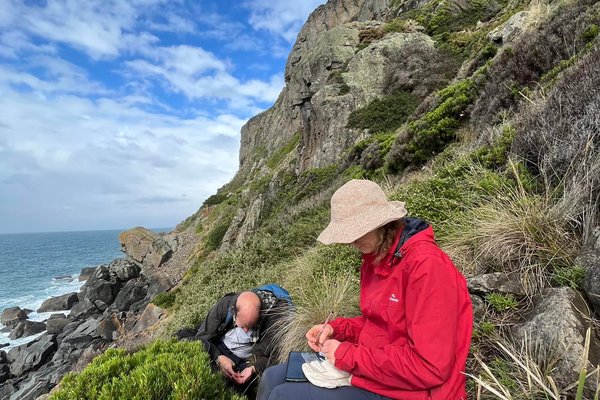Searching for snails across the Pacific, part 1: Rarotonga, Cook Islands
After years of studying snails on Australia’s Lord Howe Island and Norfolk Island, Drs Isabel Hyman and Frank Köhler began to cast their net wider in search of closely related species.
Since 2019, we have been studying the land snail radiations on Lord Howe Island and Norfolk Island. These two islands are hotspots of land snail diversity in Australia, with endemic radiations of more than 120 species between them, representing 11 families. For some families, such as the Charopidae (pinwheel snails), there are clear connections to Australia and New Zealand. However, other families such as the Microcystidae (glass snails) have no close relatives in Australia, New Zealand or New Caledonia. This led us to ponder: where did these groups originate, and where are their nearest relatives? After receiving funding from the Australia and Pacific Science Foundation, we embarked on a series of field trips across the Pacific to try to answer these questions. Here is the first in a series of blogs about our experiences.

© Isabel Hyman
Our first destination was Rarotonga in the Cook Islands. This far-flung archipelago lies in the South Pacific Ocean, about 2,300 km east of Fiji and 3,000 northeast of New Zealand. Rarotonga is the largest and most heavily populated island in the archipelago. The populated areas are all along the coastline of the circular island while the inner part, which is made up of a series of very tall peaks, still retains its natural vegetation.

© Isabel Hyman
We began our trip with a visit to Gerald McCormack, the founding Director of the Cook Islands Natural Heritage Trust. He has a detailed, encyclopaedic knowledge of the local flora and fauna, and designed and populates the Cook Islands Biodiversity and Ethnobiology Database which includes 4,500 Cook Island plant and animal species. One of our endeavours would be to confirm species identifications and provide live images for the database, thus providing taxonomic support for the community in our areas of expertise.
Gerald started by taking us to see some species found within the settled area, living in the storm-deposited coral sand and rubble. One of the species is known locally as the pūpū, and is very important to the community because it forms the basis of traditional craft, being made into necklaces. He also provided us with maps and directions for the more rugged walks we were to undertake.

© Isabel Hyman
The rest of our trip was filled with days collecting snails through the lush, green interior of the island (with occasional interludes of marine collecting with our colleague Bruce Jenkins), including intrepid climbs to high mountain peaks topped with cloud forest – of which there are several! – with stunning views. All in all, we found 37 different land snail species, including several species of glass snails (microcystids) – which was of great interest to us, since this is a dominant group on Lord Howe Island and Norfolk Island.
Gerald’s database listed the presence of four microcystid genera on Rarotonga: Lamprocystis, Diastole, Liardetia and the introduced Kororia. Previous surveys had indicated that there were several undescribed Lamprocystis species present on the island, all found on the highest peaks, as well as some already described lowland species. In the genus Diastole there was a single widespread species reported, Diastole conula. We found considerably less abundance and diversity than expected, leading us to wonder if there could be a seasonal nature to the presence of this endemic group, or whether it had suffered any impacts causing recent decline. We hope to carry out a repeat survey in the future to check on the status of the glass snails.

© Isabel Hyman
However, we did find widespread species Liardetia samoensis and Diastole conula (pictured), as well as a hitherto unrecorded, undescribed second species of Diastole. We also found Lamprocystis globosa and two undescribed species of Lamprocystis on the mountain summits of Te Ko’u (588 m) and Te Manga (658 m). The most common glass snail found was the introduced Kororia palaensis.

© Isabel Hyman
So, did any of these turn out to be closely related to our Lord Howe Island and Norfolk Island micrcocystids? Of all the Rarotonga groups, the genus Diastole is the closest relative to the Australian island taxa. However, for now the jury is still out until we have completed our Pacific Island sampling – so watch out for the next instalment!
Dr Isabel Hyman, Research Scientist, Malacology, Australian Museum Research Institute.
Acknowledgements
Funding for this project was provided by the Australia and Pacific Science Foundation and by a private donation from Bruce Jenkins. We would like to thank Gerald McCormack, Kirby Morejohn and Bruce Jenkins for their support on Rarotonga.
Related links
CIBED search results for the terrestrial land snails of the Cook Islands:
Guardian article:
AMRI blogs:
- https://australian.museum/blog/amri-news/recovery-and-discovery-rare-snails-on-lord-howe-island/
- https://australian.museum/blog/amri-news/magnificent-discoveries-on-lord-howe-island/
- https://australian.museum/blog/amri-news/rare-snail-species-found-alive-on-norfolk-island-after-130-years/
- https://australian.museum/blog/amri-news/species-assumed-extinct-rediscovered-on-norfolk-island/
Publications:












